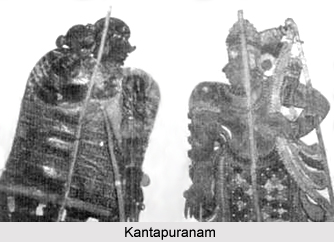 Puranas in Tamil literature were mainly adapted from the Sanskrit literary works and Hindu religious texts. Several attempts were made by various renowned Tamil poets to compose Tamil Puranas that were based on the Sanskrit Puranas. Amongst the Tamil Puranas that were written in the ancient era, the Kantapuranam, also known as Kantha Puranam, was perhaps the most significant in Tamil literature. The literary work of Kantapuranam or Kantha Puranam comprises of more than ten thousand verses that are devoted to Lord Kartikeya or Murugan in Tamil, a Hindu deity considered as the son of Lord Shiva. It is based on the Sanskrit Purana titled Civacankara Cankitai.
Puranas in Tamil literature were mainly adapted from the Sanskrit literary works and Hindu religious texts. Several attempts were made by various renowned Tamil poets to compose Tamil Puranas that were based on the Sanskrit Puranas. Amongst the Tamil Puranas that were written in the ancient era, the Kantapuranam, also known as Kantha Puranam, was perhaps the most significant in Tamil literature. The literary work of Kantapuranam or Kantha Puranam comprises of more than ten thousand verses that are devoted to Lord Kartikeya or Murugan in Tamil, a Hindu deity considered as the son of Lord Shiva. It is based on the Sanskrit Purana titled Civacankara Cankitai.
The Kantapuranam is composed by the well known Tamil poet Kacciyappa Civaccarriyar or Kach Chiyappa Chivakariyar. It provides elaborate narration about the life or Lord Murugan (Kartikeya) starting from his birth, his early years, his growing, performance of miracles, to Murugan`s war with Curapatman (Churapathman). The Tamil work of Kantapuranam also mentions in details about the marriage of Lord Murugan with Teyvayanai and even his divine love affair with Valli. The poet Kacciyappa Civaccarriyar observed the conventions lay down by the Tamil literary traditions while composing this much venerated devotional work in Tamil language. Further more, he distinguished himself in describing the scenes of nature and it beauty and magnificence. As Kantapuranam or Kantha Puranam is renowned for its poetic fineness and brilliance, it has been considered by various authors and scholars as probably the best literary piece among the Puranas in Tamil literature.
Other poets also composed various Puranas in Tamil which were also based on Sanskrit works, like the literary work of Cevvaiccutuvar was adapted from the Bhagavatam in Sanskrit language. The Tamil poet Aracakecari translated the work of Raghuvamsa by Kalidasa into Tamil language. The poetic work comprised of two thousand four hundred and eighty verses. Another poet, Pukalenti described in details the tale of Nalan, through excellent venpas, as provided in the Hindu epic Mahabharata in Sanskrit. A similar account was narrated by Ativiraramar of the Pandya royal family, in viruttam metre. Ativiraramar composed other works such as Ilinkapuranam and Kurmapuranam in Tamil language.
The Vinayakapuranam was translated into Tamil by Kacciyappa Munivar. Virakavirayar composed the Ariccantira puranam in a mellifluous and poignant poetic style. The poetry in this Tamil literary work contains the aptitude to capture the mind of the readers as the composition is rather heartening. Vatamalaiyappar, another Tamil poet translated Macca Puranam into Tamil language.
During this period, one of the Jain scholars named Mantala Purutar translated a Sanskrit Jain work titled Atipuranam into Tamil with the description Sri Purdnam. The Jain work is composed in manippiravala style. The Kayacintamani is another Jain work which is also composed in a similar manner. Another Jain work named Merumantarapuranam was translated by Vamana Munivar into Tamil language. It is composed in a natural Tamil style without many Sanskrit loan words. Aranericcaram is an ethical Tamil work written by another Jain author, during this epoch.



















